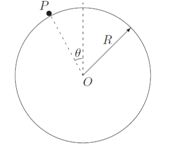Assignment:
This question considers the motion of an object of mass m sliding on the outside of a cylinder of radius R whose axis is horizontal. The motion occurs in the vertical plane, and the surface of the cylinder is rough — the coefficient of sliding friction is μ'. The diagram below shows the position of the object when it is at an angle θ from the upward vertical through the axis of the cylinder O. Model the object as a particle.

Q1. Please draw a force diagram for the forces acting on the particle, defining any forces that you introduce.
Q2. Why is it better to use plane polar unit vectors. Please include them on the force diagram. How do I express the acceleration of the particle in terms of these unit vectors?
Q3. How do I express each of the forces acting on the particle as a vector in terms of the plane polar unit vectors?
Q4. How would I write down a differential equation of motion for the particle, and how would Ithen obtain two scalar differential equations?
Q5. If μ
Q6. Why it is not possible to use conservation of energy for this system?
Q7. How would I use the friction condition to show that by eliminating the unknown magnitudes of forces in the two equations in part (d), this results in the equation
Rθ¨ μ' Rθ·2 =gsinθ - μ' gcosθ
Q8. Use the substitution
θ¨ = d/dθ (1/2θ·2)
How would I transform the differential equation in part 7 into
dz/dθ = cZ = a cosθ + b cosθ,
where Z = 1/2θ·2 and a, b, c are constants.
Q9. How would I express a, b and c in terms of μ'and g.
Provide complete and step by step solution for the question and show calculations and use formulas.